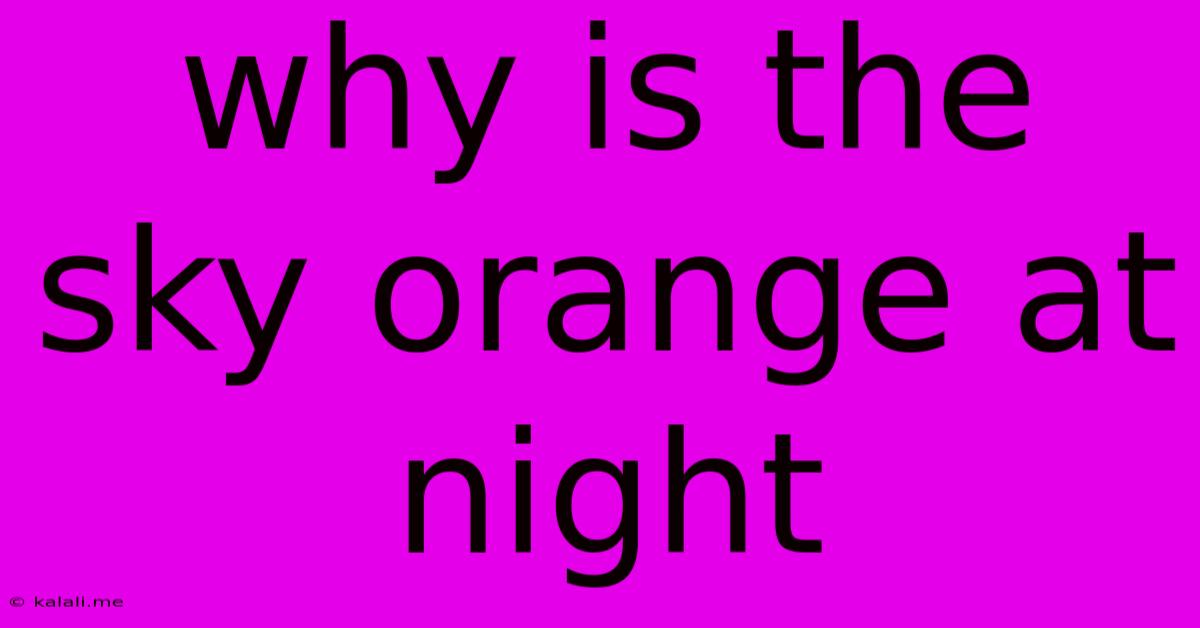Why Is The Sky Orange At Night
Kalali
May 19, 2025 · 3 min read

Table of Contents
Why is the Sky Orange at Night? A Deep Dive into Atmospheric Scattering
The mesmerizing orange hues painting the evening sky are a spectacle we often take for granted. But what's the science behind this breathtaking phenomenon? The answer lies in the way sunlight interacts with the Earth's atmosphere, a process called Rayleigh scattering. This article delves into the physics behind this beautiful display, explaining why the sky appears orange at sunset and sunrise.
Understanding Rayleigh Scattering and its Role in Sky Color
Sunlight is made up of all the colors of the rainbow. When sunlight enters the Earth's atmosphere, it collides with tiny air molecules like nitrogen and oxygen. Rayleigh scattering dictates that shorter wavelengths of light, like blue and violet, are scattered more effectively than longer wavelengths, like red and orange. This is why the sky appears blue during the day – the blue light is scattered in all directions.
The Magic of Sunset and Sunrise
At sunset and sunrise, the sun's light has to travel through a much thicker layer of the atmosphere to reach our eyes. This longer path significantly increases the amount of scattering. As the blue light is scattered away over long distances, the longer wavelengths – reds, oranges, and yellows – are left to dominate the visible spectrum, creating the stunning orange and red glow we witness.
Factors Influencing the Intensity of Orange Hues:
Several factors influence the intensity and vibrancy of the orange color at sunset and sunrise:
- Atmospheric Conditions: The presence of dust, water vapor, and pollutants in the air can significantly alter the scattering of light. More particles mean more scattering, leading to richer, more intense colors. Volcanic eruptions, for instance, can produce exceptionally vibrant sunsets due to increased atmospheric particulates. This is also true for pollution.
- Altitude of the Sun: The lower the sun's angle in the sky, the longer the path its light must travel through the atmosphere, enhancing the scattering effect.
- Geographic Location: Locations with clearer skies and less atmospheric pollution will typically exhibit more vibrant sunset colors.
- Cloud Cover: The presence of clouds can affect the visibility of the sunset colors. Clouds can either scatter the light further, intensifying the colors, or block the light altogether.
Beyond Orange: The Spectrum of Sunset Colors
While orange is a prominent color, sunsets often display a whole spectrum of colors, from deep reds and fiery oranges to soft yellows and pinks. This variety arises from the complex interplay of different wavelengths of light interacting with the atmosphere's varied composition.
Conclusion: A Daily Symphony of Light and Atmosphere
The orange sky at night is a testament to the intricate dance between sunlight and the Earth's atmosphere. It's a reminder of the stunning beauty found in the everyday phenomena around us, fueled by the principles of physics and the ever-changing conditions of our planet's atmosphere. Next time you witness a vibrant sunset, remember the fascinating science behind its captivating colors. Appreciating the orange glow becomes even more rewarding with an understanding of the atmospheric processes at play.
Latest Posts
Latest Posts
-
How Many Ayahs Are In The Quran
May 19, 2025
-
Through Heaven And Earth I Alone Am The Honored One
May 19, 2025
-
Looking Forward To Talking To You
May 19, 2025
-
Your Welcome Or You Re Welcome
May 19, 2025
-
How Long Can You Keep Bolognese In The Fridge
May 19, 2025
Related Post
Thank you for visiting our website which covers about Why Is The Sky Orange At Night . We hope the information provided has been useful to you. Feel free to contact us if you have any questions or need further assistance. See you next time and don't miss to bookmark.